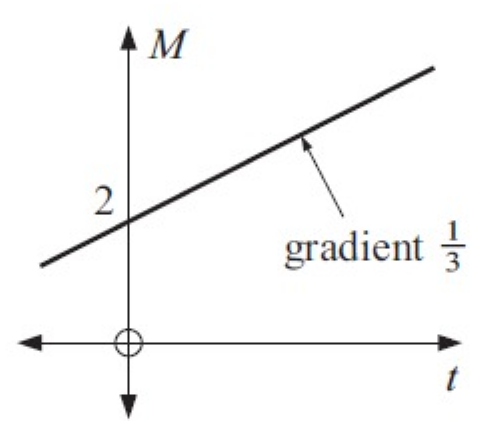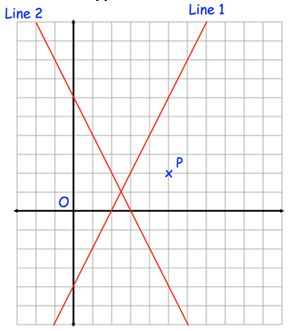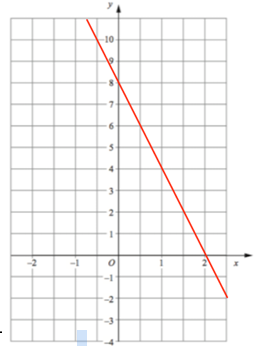WRITE THE EQUATION OF A LINE FROM SLOPE AND Y INTERCEPT
Find the equation from the given gradient and y-intercept.
Example 1 :
Gradient = 2 and y – intercept = 7
Solution :
Gradient(m) = 2
y – intercept(b) = 7
Equation of a straight line y = mx + b
y = 2x + 7
So, the required equation is y = 2x + 7
Example 2 :
Gradient = 4 and y – intercept = -6
Solution :
Gradient(m) = 4
y – intercept(b) = - 6
Equation of a straight line y = mx + b
y = 4x - 6
So, the required equation is y = 4x – 6
Example 3 :
Gradient = -3 and y – intercept = -1
Solution :
Gradient(m) = - 3
y – intercept(b) = - 1
Equation of a straight line y = mx + b
y = -3x - 1
So, the required equation is y = -3x – 1
Example 4 :
Gradient = – 1/2 and y – intercept = 2
Solution :
Gradient m = - 1/2
y – intercept b = 2
Equation of a straight line y = mx + b
y = (-1/2)x + 2
So, the required equation is y = (-1/2)x + 2.
Example 5 :
Gradient = 0 and y – intercept = 8
Solution :
Gradient(m) = 0
y – intercept(b) = 8
Equation of a straight line y = mx + b
y = 0x + 8
So, the required equation is y = 8.
Example 6 :
Undefined gradient, through (2, 5)
Solution :
Gradient(m) = 1/0
By using slope point formula,
(y – y1) = m (x – x1)
Since the given line is passing through the point (2, 5)
(2, 5)------>(x1, y1)
(y – 5) = 1/0 (x – 2)
0 = 1 (x – 2)
x – 2 = 0
x = 2
So, the required equation is x = 2.
Example 7 :

Solution :
Slope of a line = 1/3
y – intercept(b) = 2
Equation of a straight line y = mx + b
y = 1/3x + 2
3y = x + 6
x – 3y + 6 = 0
So, the required equation is x – 3y + 6 = 0.
Example 8 :
A line has equation y = 2x + 6
- The line crosses the x−axis at the point A
- The line crosses the y−axis at the point B
- The point C has coordinates (1, 8)
(a) Find the coordinates of the point A
(b) Find the coordinates of the point B
(c) Find the equation of the straight line passing through the points A and C.
Solution :
y = 2x + 6
a) To find the x-intercept, we put y = 0
0 = 2x + 6
2x = -6
x = -6/2
x = -3
Coordinate A (-3, 0)
b) To find the y-intercept, we put x = 0
y = 2(0) + 6
y = 0 + 6
y = 6
Coordinate B(0, 6)
c) Equation of line passes through A and C :
A (-3, 0) and C (1, 8)
(y – y1) = m (x – x1)
Slope (m) = (y2 - y1)/(x2 - x1)
= (8 - 0) / (1 + 3)
= 8/4
= 2
y - 0 = 2(x - (-3))
y = 2(x + 3)
y = 2x + 6
Example 9 :
Do the lines y = 3x + 1 and 4x − 2y + 3 = 0 have the same gradients?
Solution :
y = 3x + 1
Slope of the line comparing with y = mx + b
Slope (m) = 3
4x − 2y + 3 = 0
Slope of the line by converting this equation into slope intercept form.
2y = 4x + 3
y = (4x/2) + (3/2)
y = 2x + (3/2)
Slope (m) = 2
So, the lines donot have same slope.
Example 10 :
Line 1 has equation y = 3x − 12
(a) Find the coordinates of P
(b) Find the equation of line 2.

Solution :
a) The point P is (5, 2).
b) Equation of line 2 :
From y-intercept of line 2,
Run = 3 and run = -6
Slope = rise / run
= 3/(-6)
= -1/2
y-intercept = 6
y = mx + b
y = (-1/2)x + 6
y = -x/2 + 6
y = (-x + 12)/2
2y = -x + 12
x + 2y = 12
So, the required equation is x + 2y = 12.
Example 11 :
Lexi says the line below has an equation of y = −2x + 8 Explain her mistake

Solution :
From the graph of line given above, y-intercept = 8
Rise = -8 and run = 4
Equation of line :
Slope = rise / run
= -8/4
= -2
y = mx + b
y = -2x + 8
She has got correct answers.
Example 12 :
What is the equation of the line that passes through the point (0, 5) and is parallel to the graph of
y = 7x + 4
in the xy-plane?
A) y = 5x B) y = 7x + 5 C) y = 7x D) y = 5x + 7
Solution :
Since the given line is parallel to y = 7x + 4
comparing with y = mx + b
m = 7
Equation of the line passes through (0, 5) and slope = 7
y - y1 = m(x - x1)
y - 5 = 7(x - 0)
y - 5 = 7x
y = 7x + 5
Kindly mail your feedback to v4formath@gmail.com
We always appreciate your feedback.
©All rights reserved. onlinemath4all.com
Recent Articles
-
Hcf and Lcm Word Problems
Nov 21, 25 09:03 AM
Hcf and Lcm Word Problems -
10 Hard SAT Math Questions (Part - 35)
Nov 21, 25 07:36 AM
10 Hard SAT Math Questions (Part - 35) -
Problems on Numbers
Nov 21, 25 04:34 AM
Problems on Numbers
